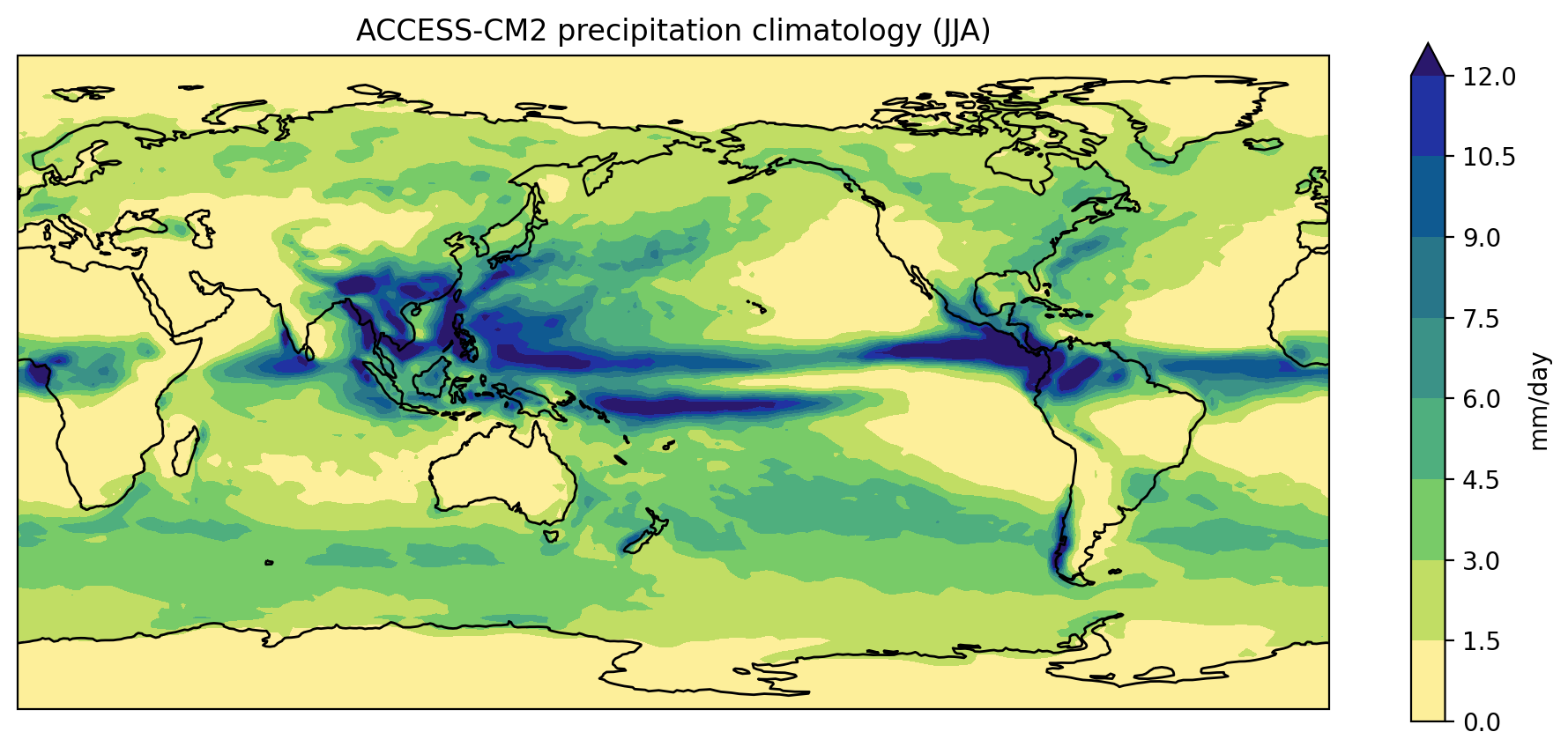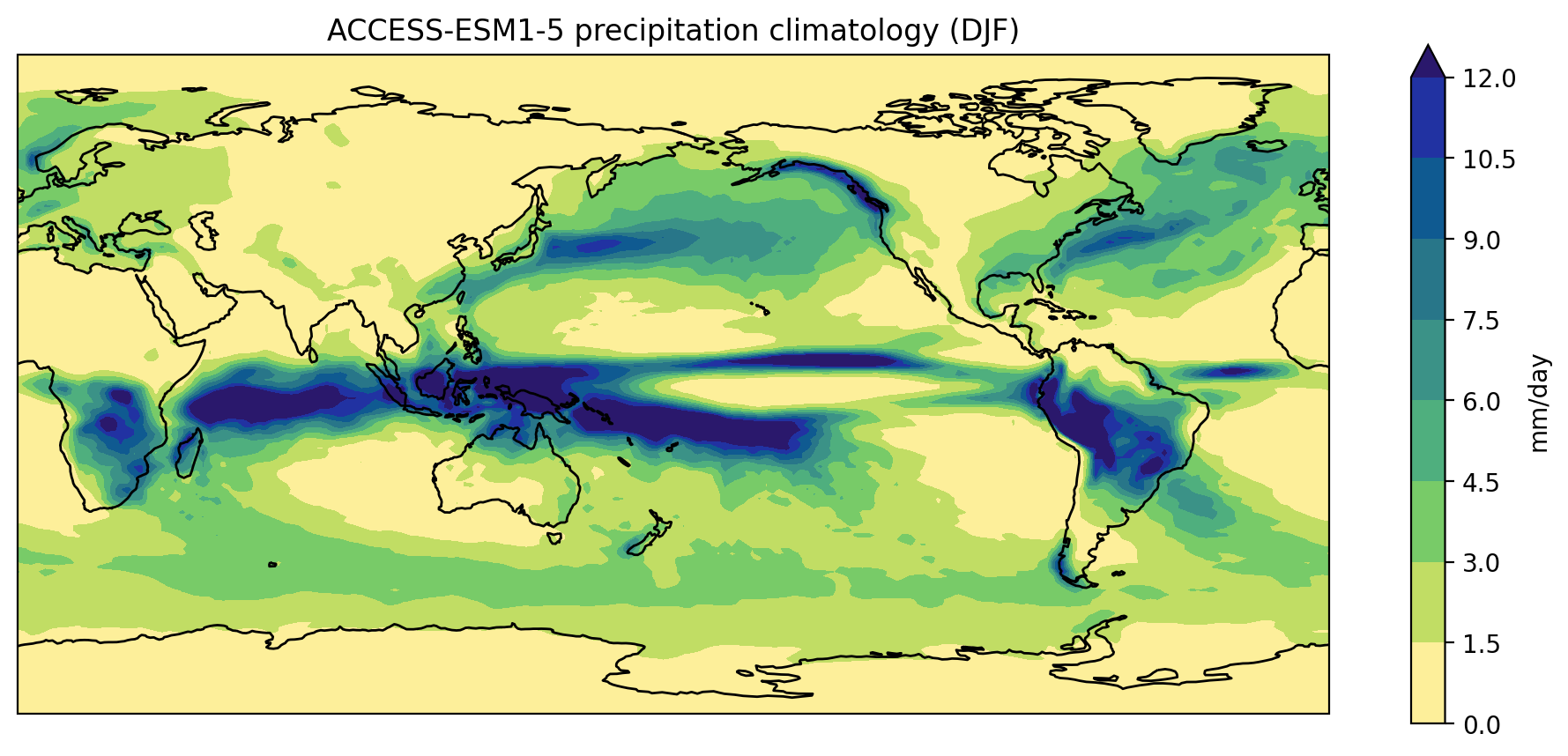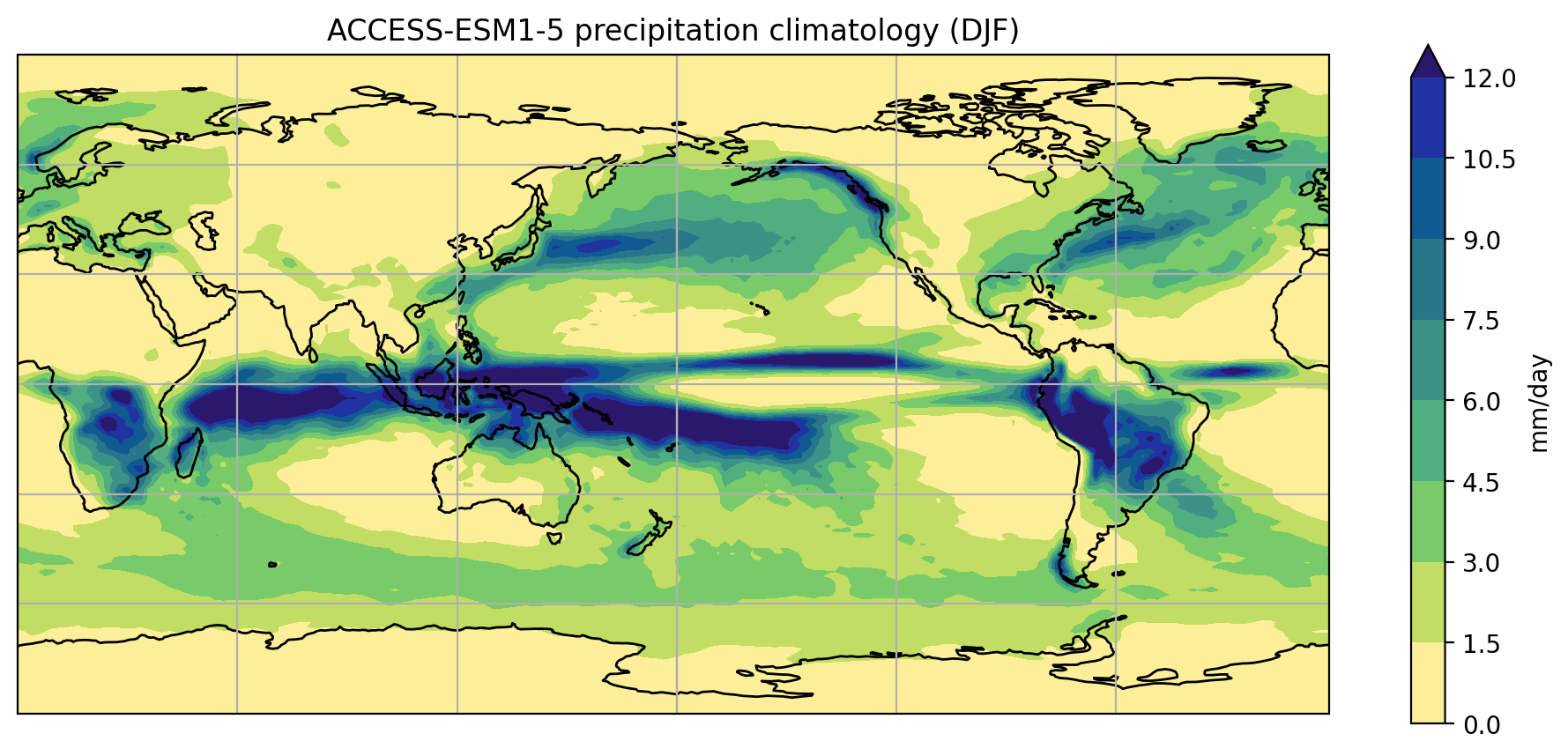Functions
Last updated on 2024-07-25 | Edit this page
Overview
Questions
- How can I define my own functions?
Objectives
- Define a function that takes parameters.
- Use docstrings to document functions.
- Break our existing plotting code into a series of small, single-purpose functions.
In the previous lesson we created a plot of the ACCESS-CM2 historical precipitation climatology using the following commands:
PYTHON
import xarray as xr
import cartopy.crs as ccrs
import matplotlib.pyplot as plt
import numpy as np
import cmocean
accesscm2_pr_file = "data/pr_Amon_ACCESS-CM2_historical_r1i1p1f1_gn_201001-201412.nc"
ds = xr.open_dataset(accesscm2_pr_file)
clim = ds["pr"].groupby("time.season").mean("time", keep_attrs=True)
clim.data = clim.data * 86400
clim.attrs['units'] = "mm/day"
fig = plt.figure(figsize=[12,5])
ax = fig.add_subplot(111, projection=ccrs.PlateCarree(central_longitude=180))
clim.sel(season="JJA").plot.contourf(
ax=ax,
levels=np.arange(0, 13.5, 1.5),
extend="max",
transform=ccrs.PlateCarree(),
cbar_kwargs={"label": clim.units},
cmap=cmocean.cm.haline_r,
)
ax.coastlines()
model = ds.attrs["source_id"]
title = f"{model} precipitation climatology (JJA)"
plt.title(title)
plt.show()
If we wanted to create a similar plot for a different model and/or
different month, we could cut and paste the code and edit accordingly.
The problem with that (common) approach is that it increases the chances
of a making a mistake. If we manually updated the season to ‘DJF’ for
the clim.sel(season= command but forgot to update it when
calling plt.title, for instance, we’d have a mismatch
between the data and title.
The cut and paste approach is also much more time consuming. If we
think of a better way to create this plot in future (e.g. we might want
to add gridlines using plt.gca().gridlines()), then we have
to find and update every copy and pasted instance of the code.
A better approach is to put the code in a function. The code itself then remains untouched, and we simply call the function with different input arguments.
PYTHON
def plot_pr_climatology(pr_file, season, gridlines=False):
"""Plot the precipitation climatology.
Args:
pr_file (str): Precipitation data file
season (str): Season (3 letter abbreviation, e.g. JJA)
gridlines (bool): Select whether to plot gridlines
"""
ds = xr.open_dataset(pr_file)
clim = ds["pr"].groupby("time.season").mean("time", keep_attrs=True)
clim.data = clim.data * 86400
clim.attrs["units"] = "mm/day"
fig = plt.figure(figsize=[12,5])
ax = fig.add_subplot(111, projection=ccrs.PlateCarree(central_longitude=180))
clim.sel(season=season).plot.contourf(
ax=ax,
levels=np.arange(0, 13.5, 1.5),
extend="max",
transform=ccrs.PlateCarree(),
cbar_kwargs={"label": clim.units},
cmap=cmocean.cm.haline_r,
)
ax.coastlines()
if gridlines:
plt.gca().gridlines()
model = ds.attrs["source_id"]
title = f"{model} precipitation climatology ({season})"
plt.title(title)The docstring allows us to have good documentation for our function:
OUTPUT
Help on function plot_pr_climatology in module __main__:
plot_pr_climatology(pr_file, season, gridlines=False)
Plot the precipitation climatology.
Args:
pr_file (str): Precipitation data file
season (str): Season (3 letter abbreviation, e.g. JJA)
gridlines (bool): Select whether to plot gridlinesWe can now use this function to create exactly the same plot as before:
PYTHON
plot_pr_climatology("data/pr_Amon_ACCESS-CM2_historical_r1i1p1f1_gn_201001-201412.nc", "JJA")
plt.show()
Plot a different model and season:
PYTHON
plot_pr_climatology("data/pr_Amon_ACCESS-ESM1-5_historical_r1i1p1f1_gn_201001-201412.nc", "DJF")
plt.show()
Or use the optional gridlines input argument to change
the default behaviour of the function (keyword arguments are usually
used for options that the user will only want to change
occasionally):
PYTHON
plot_pr_climatology(
"data/pr_Amon_ACCESS-ESM1-5_historical_r1i1p1f1_gn_201001-201412.nc",
"DJF",
gridlines=True,
)
plt.show()
Short functions
Our plot_pr_climatology function works, but at 16 lines
of code it’s starting to get a little long. In general, people can only
fit around 7-12 pieces of information in their short term memory. The
readability of your code can therefore be greatly enhanced by keeping
your functions short and sharp. The speed at which people can analyse
their data is usually limited by the time it takes to
read/understand/edit their code (as opposed to the time it takes the
code to actually run), so the frequent use of short, well documented
functions can dramatically speed up your data science.
- Cut and paste the
plot_pr_climatologyfunction (defined in the notes above) into your own notebook and try running it with different input arguments. - Break the contents of
plot_pr_climatologydown into a series of smaller functions, such that it reads as follows:
PYTHON
def plot_pr_climatology(pr_file, season, gridlines=False):
"""Plot the precipitation climatology.
Args:
pr_file (str): Precipitation data file
season (str): Season (3 letter abbreviation, e.g. JJA)
gridlines (bool): Select whether to plot gridlines
"""
ds = xr.open_dataset(pr_file)
clim = ds["pr"].groupby("time.season").mean("time", keep_attrs=True)
clim = convert_pr_units(clim)
create_plot(clim, ds.attrs["source_id"], season, gridlines=gridlines)
plt.show()In other words, you’ll need to define new
convert_pr_units and create_plot functions
using code from the existing plot_pr_climatology
function.
PYTHON
def convert_pr_units(da):
"""Convert kg m-2 s-1 to mm day-1.
Args:
da (xarray.DataArray): Precipitation data
"""
da.data = da.data * 86400
da.attrs['units'] = "mm/day"
return da
def create_plot(clim, model, season, gridlines=False):
"""Plot the precipitation climatology.
Args:
clim (xarray.DataArray): Precipitation climatology data
model (str) : Name of the climate model
season (str): Season
Kwargs:
gridlines (bool): Select whether to plot gridlines
"""
fig = plt.figure(figsize=[12,5])
ax = fig.add_subplot(111, projection=ccrs.PlateCarree(central_longitude=180))
clim.sel(season=season).plot.contourf(
ax=ax,
levels=np.arange(0, 13.5, 1.5),
extend="max",
transform=ccrs.PlateCarree(),
cbar_kwargs={"label": clim.units},
cmap=cmocean.cm.haline_r,
)
ax.coastlines()
if gridlines:
plt.gca().gridlines()
title = f"{model} precipitation climatology ({season})"
plt.title(title)
def plot_pr_climatology(pr_file, season, gridlines=False):
"""Plot the precipitation climatology.
Args:
pr_file (str): Precipitation data file
season (str): Season (3 letter abbreviation, e.g. JJA)
gridlines (bool): Select whether to plot gridlines
"""
ds = xr.open_dataset(pr_file)
clim = ds["pr"].groupby("time.season").mean("time", keep_attrs=True)
clim = convert_pr_units(clim)
create_plot(clim, ds.attrs["source_id"], season, gridlines=gridlines)
plt.show()Writing your own modules
We’ve used functions to avoid code duplication in this particular notebook/script, but what if we wanted to convert precipitation units from kg m-2 s-1 to mm/day in a different notebook/script?
To avoid cutting and pasting from this notebook/script to another,
the solution would be to place the convert_pr_units
function in a separate script full of similar functions.
For instance, we could put all our unit conversion functions in a
script called unit_conversion.py. When we want to convert
precipitation units (in any script or notebook we’re working on), we can
simply import that “module” and use the convert_pr_units
function:
No copy and paste required!
Key Points
- Define a function using
def name(...params...). - The body of a function must be indented.
- Call a function using
name(...values...). - Use
help(thing)to view help for something. - Put docstrings in functions to provide help for that function.
- Specify default values for parameters when defining a function using
name=valuein the parameter list. - The readability of your code can be greatly enhanced by using numerous short functions.
- Write (and import) modules to avoid code duplication.
